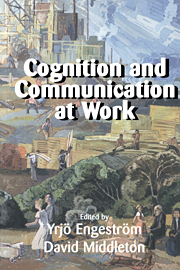Book contents
- Frontmatter
- Contents
- Contributors
- Acknowledgments
- 1 Introduction: Studying work as mindful practice
- 2 Distributed cognition in an airline cockpit
- 3 Constituting shared workspaces
- 4 Seeing as situated activity: Formulating planes
- 5 Convergent activities: Line control and passenger information on the London Underground
- 6 Users and designers in mutual activity: An analysis of cooperative activities in systems design
- 7 System disturbances as springboard for development of operators' expertise
- 8 Expert and novice differences in cognition and activity: A practical work activity
- 9 The tensions of judging: Handling cases of driving under the influence of alcohol in Finland and California
- 10 Talking work: Argument, common knowledge, and improvisation in teamwork
- 11 The collective construction of scientific genius
- 12 Experience and the collective nature of skill
- 13 Working together: Symbolic interactionism, activity theory, and information systems
- 14 On the ethnography of cooperative work
- Index
13 - Working together: Symbolic interactionism, activity theory, and information systems
Published online by Cambridge University Press: 05 June 2012
- Frontmatter
- Contents
- Contributors
- Acknowledgments
- 1 Introduction: Studying work as mindful practice
- 2 Distributed cognition in an airline cockpit
- 3 Constituting shared workspaces
- 4 Seeing as situated activity: Formulating planes
- 5 Convergent activities: Line control and passenger information on the London Underground
- 6 Users and designers in mutual activity: An analysis of cooperative activities in systems design
- 7 System disturbances as springboard for development of operators' expertise
- 8 Expert and novice differences in cognition and activity: A practical work activity
- 9 The tensions of judging: Handling cases of driving under the influence of alcohol in Finland and California
- 10 Talking work: Argument, common knowledge, and improvisation in teamwork
- 11 The collective construction of scientific genius
- 12 Experience and the collective nature of skill
- 13 Working together: Symbolic interactionism, activity theory, and information systems
- 14 On the ethnography of cooperative work
- Index
Summary
Introduction
There can be no doubt that in 1896 John Dewey was anticipating important aspects of what we now know as activity theory.
(Tolman & Pikkola, 1989, p. 46)I find myself these days as a point in a dialogue between three voices: activity theory, American symbolic interactionism (pragmatism), and the development of large-scale information systems. I write this chapter in order to enliven that dialogue. It might simply be a Whiggish exercise or a history of ideas-in-common, such are the density of the threads that unite their founders and practitioners. But my concern here is not whether both Mead and Vygotsky both read Pavlov (of course they did), or whether their students read and taught each other (some did and do), nor simply about drawing structural analogies between lines of inquiry (although they are striking).
I'm more concerned here to make a tool that will extend the usefulness of symbolic interactionism to the communities of practice (Wenger, 1990; Lave & Wenger, 1992) of activity theory and information-systems research. The three approaches afford each other–a word used mostly in this context by activity theorists, drawn from Gibson's ecological psychology (Gibson, 1979). Symbolic interactionism affords information-systems research a body of empirical studies of work and interaction, in the context of an elaborated philosophical framework that emphasizes collectivities and consequences. For activity theory, it is rich in understanding the subtle differences between types of work and practice, and how those are realized within and between communities.
- Type
- Chapter
- Information
- Cognition and Communication at Work , pp. 296 - 318Publisher: Cambridge University PressPrint publication year: 1996
- 44
- Cited by



